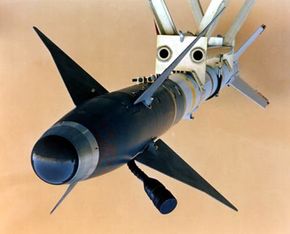Tracking: Infrared
The Sidewinder seeker is something like the CCD in a video camera. It has an array of sensors that generate an electrical signal when exposed to the infrared light given off by hot objects. Since it only sees things in terms of "very hot" and "not very hot," the infrared system is much simpler than a visible-light detection system (an ordinary video camera). Additionally, infrared seekers don't need an outside light source, so they work perfectly well night or day.
In the current Sidewinder models, the infrared sensor array is coupled with a conical scanning system. The basic idea of a conical scanning system is to continually move the feed horn -- the assembly of lenses and mirrors that directs light to the sensor -- around in a small circle (to visualize this, imagine holding the eraser end of a pencil steady in one hand while moving the pointed end around in a circle). As a whole, the moving feedhorn scans a large section of the sky. The guidance control system figures out where the target is based on fluctuations in the detected infrared light as the feed horn moves around the circle. If the target is to the left of the missile, for example, the sensor will detect greater infrared light when the feed horn is aimed to the left than when it is aimed to the right.
Advertisement
In the next section, you'll find out more about the guidance control system.
